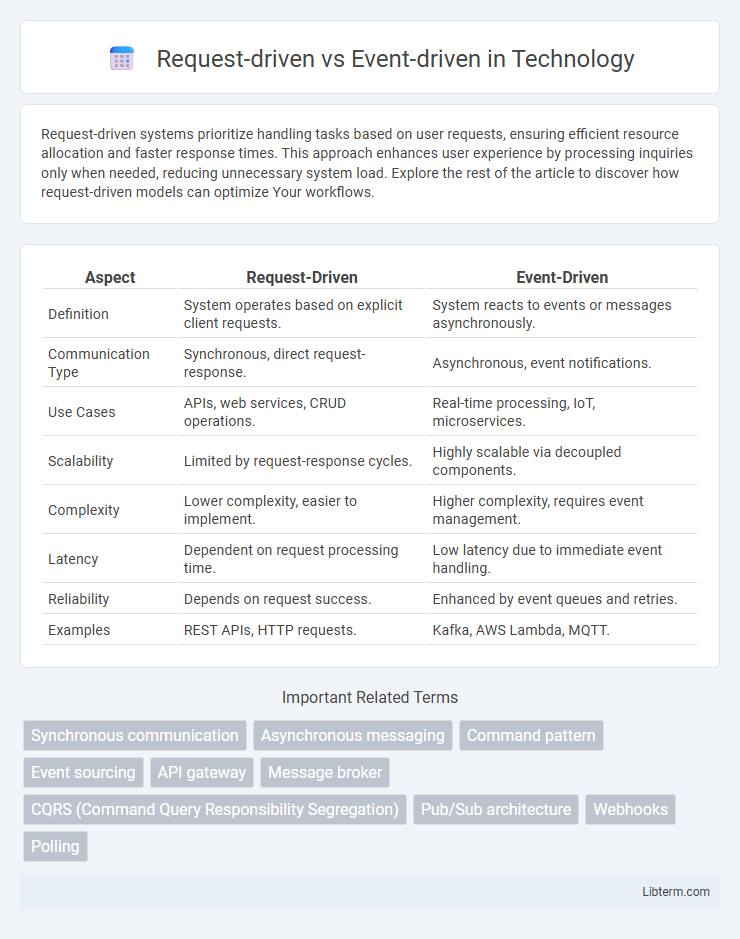Request-driven systems prioritize handling tasks based on user requests, ensuring efficient resource allocation and faster response times. This approach enhances user experience by processing inquiries only when needed, reducing unnecessary system load. Explore the rest of the article to discover how request-driven models can optimize Your workflows.
Table of Comparison
| Aspect | Request-Driven | Event-Driven |
|---|---|---|
| Definition | System operates based on explicit client requests. | System reacts to events or messages asynchronously. |
| Communication Type | Synchronous, direct request-response. | Asynchronous, event notifications. |
| Use Cases | APIs, web services, CRUD operations. | Real-time processing, IoT, microservices. |
| Scalability | Limited by request-response cycles. | Highly scalable via decoupled components. |
| Complexity | Lower complexity, easier to implement. | Higher complexity, requires event management. |
| Latency | Dependent on request processing time. | Low latency due to immediate event handling. |
| Reliability | Depends on request success. | Enhanced by event queues and retries. |
| Examples | REST APIs, HTTP requests. | Kafka, AWS Lambda, MQTT. |
Introduction to Request-Driven and Event-Driven Architectures
Request-driven architectures rely on synchronous communication where clients send explicit requests to servers and await responses, ensuring direct interaction and immediate feedback. Event-driven architectures operate asynchronously, with components producing and consuming events independently, enabling decoupled systems that react to state changes or messages in real-time. Understanding these foundational differences is crucial for designing scalable and responsive applications adapting to varying workload demands.
Defining Request-Driven Systems
Request-driven systems operate through direct client-initiated interactions, where each request from the user triggers a specific response from the server, ensuring synchronous communication and precise control flow. These systems excel in scenarios requiring immediate feedback and tightly coupled processes, such as RESTful APIs and traditional client-server architectures. Key characteristics include explicit request-response cycles, predictable latency, and straightforward debugging paths.
Understanding Event-Driven Systems
Event-driven systems operate by responding to asynchronous events or messages, enabling real-time processing and dynamic interaction between system components. Unlike request-driven architectures that follow a synchronous request-response pattern, event-driven models leverage event brokers or message queues to decouple producers and consumers. This design enhances scalability, fault tolerance, and flexibility in distributed environments such as IoT applications, microservices, and real-time analytics.
Core Differences Between Request-Driven and Event-Driven
Request-driven architecture relies on a client initiating a specific request to a server, leading to a synchronous response, emphasizing direct communication and control flow. Event-driven architecture operates asynchronously, where events trigger responses from decoupled components, promoting scalability and flexibility in handling dynamic workloads. Core differences include synchronization--with request-driven being synchronous and event-driven asynchronous--and system coupling, as request-driven systems are tightly coupled, while event-driven systems encourage loosely coupled, reactive interactions.
Use Cases for Request-Driven Approaches
Request-driven architectures excel in scenarios requiring synchronous communication, such as RESTful API interactions where clients need immediate responses for data queries or transactions. They are ideal for online banking systems, e-commerce checkouts, and real-time data retrieval applications where the client controls the timing of data exchange. This approach ensures predictable performance and simplified error handling, critical for services demanding reliable request-response cycles.
Use Cases for Event-Driven Approaches
Event-driven approaches excel in real-time data processing, such as monitoring IoT sensor data or managing user interactions in dynamic web applications. They enable scalable, asynchronous workflows in microservices architectures, enhancing responsiveness to external events like system alerts or transaction completions. Industries leveraging event-driven models include finance for fraud detection, e-commerce for personalized recommendations, and telecommunications for network monitoring.
Scalability and Performance Comparison
Request-driven architectures process client requests sequentially, which can limit scalability under high load due to resource contention and blocking operations. Event-driven systems leverage asynchronous communication, enabling better performance and higher scalability by efficiently handling numerous concurrent events without waiting for each to complete. Scalability in event-driven models is enhanced through non-blocking I/O and event loops, reducing latency and improving throughput compared to traditional request-driven designs.
Flexibility and Complexity Considerations
Request-driven architectures offer greater flexibility in controlling the flow of data between client and server, enabling precise query handling and synchronous processing. Event-driven systems excel in managing complex, asynchronous operations by decoupling components and allowing real-time event propagation, but they often introduce higher complexity in debugging and system coordination. Choosing between these paradigms depends on balancing the need for dynamic interaction flexibility against the challenges posed by event handling intricacies.
Choosing the Right Architecture for Your Application
Request-driven architecture excels in scenarios requiring synchronous interactions and immediate responses, making it ideal for user-facing applications where latency matters. Event-driven architecture suits systems needing high scalability and loose coupling, enabling asynchronous processing and real-time event handling in complex workflows. Selecting the right architecture depends on application requirements such as response time, scalability, and complexity of interactions.
Future Trends in System Architectures
Request-driven architectures rely on client-initiated queries, providing predictable interaction patterns, while event-driven architectures excel in asynchronous processing and real-time responsiveness. Future trends indicate a shift toward hybrid models integrating request-driven control with event-driven scalability to support dynamic workloads and IoT ecosystems. Advances in AI-driven orchestration and edge computing will further optimize event-driven system resilience and responsiveness in distributed environments.
Request-driven Infographic

 libterm.com
libterm.com